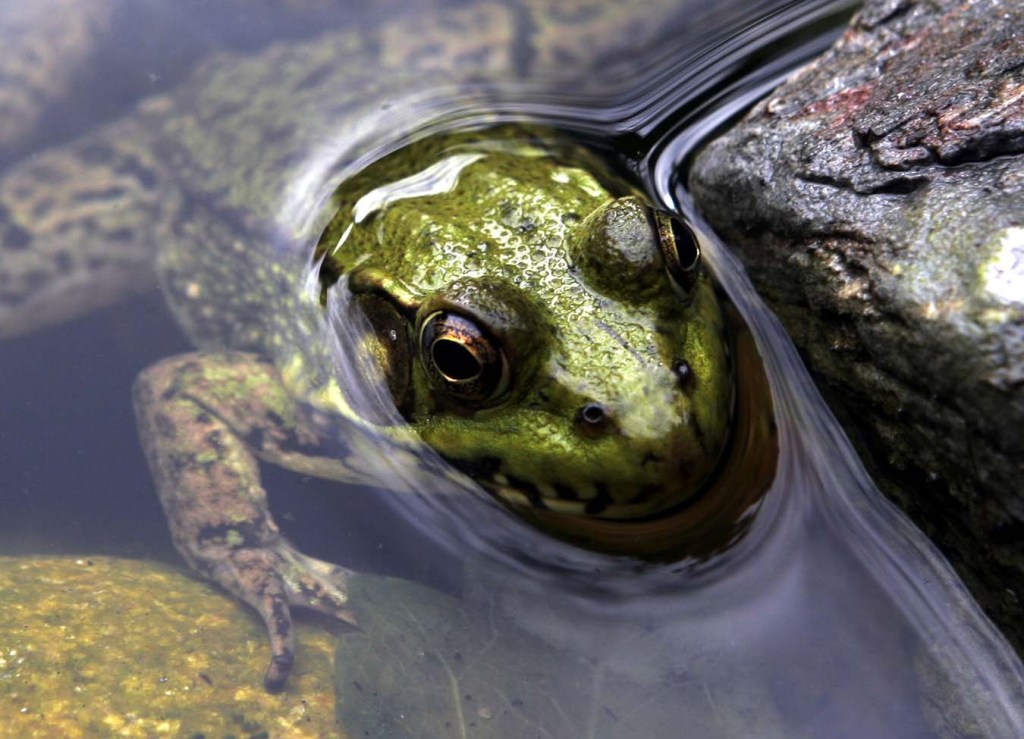
A wood frog is spotted on Middle Road in Falmouth on March 31, 2022, which was that spring’s “Big Night,” a statewide scientific study of the annual event when amphibians migrate across roadways to breeding grounds. Derek Davis/Staff Photographer
There are many ways to mark and measure when spring begins, perhaps most officially with the vernal equinox coming this week.
From a naturalist perspective, it is most fun to see, and hear, all the signs of spring across the landscapes right now. A warm early spring evening has many signs of the changing season. I’ve found myself standing outside at dusk lately, listening for the nasal ‘peent’ calls of American woodcocks.
Another common noise is the increasing chorus of frogs emerging from their brumation (the amphibian equivalent to hibernation) and finding mates. With the early spring this year, we’ve been getting a lot of inquiries about what effects – if any – the warmer-than-usual temperatures and flooding might be having on our amphibians, so we’ll discuss some of the common and thought provoking questions here.
A good place to start is with a reminder about one of the coolest events of the year for any herper (a fan of herpetology; aka the amphibian and reptile people): the Big Night. The big night typically happens on the first warm and rainy night of the spring (45 degrees or warmer) when the majority of amphibians – frogs and salamanders – emerge from the burrows where they overwintered and journey back to the vernal pools they were born in, to breed. (A vernal pool is a small temporary wetland that fills with water in spring or fall.)
Last week, we had a rainy evening with temperatures in the low 40s, but despite my best efforts walking around with a flashlight and umbrella, I couldn’t find any herps on the move. We did see a handful of reports online, but the ideal conditions will need slightly warmer temperatures.
Conditions for a Big Night may not occur until April, but it is a good idea to be prepared because you often don’t know if the weather conditions will be just right until just before it happens.
One interesting question we’ve received lately is about the impact on our amphibians from the recent flooding events. In general, that impact will be minimal, and that is mostly thanks to the distances between the areas affected by flooding and where amphibians are wintering. Coastal flooding is not a concern for amphibians since most of them avoid the salt water and won’t be near the areas seeing the most increased flooding during these recent storms. Even looking at some of the high flooding along rivers, we don’t need to be too concerned, as most amphibians are going to be high enough up (remember ‘high’ isn’t very far when you are only a few inches long) or far enough from rivers to not be an issue. Very few amphibians will be near these rivers, as many (especially salamanders) are in leaf litter or under logs across the forest floor, and most frogs and turtles are going to be in the muddy bottoms of lakes and ponds. Yes, there will be some unlucky ones that get flooded out or washed away, but I suspect it is a very low percentage of individuals that will be affected.
Another important thing to mention now is that we should limit our impact on them at this sensitive time. A recent post on Facebook from our friends at the Center for Wildlife was a nice reminder that despite these warm temperatures that might feel ideal for getting in early yard work, we need to be careful of the amphibians that are still in the ground, often in our yards. This is especially true if you were helping wildlife last fall by “leaving the leaves” in your yard. Those leaves were a great home for them and other wildlife this winter. So don’t disturb those homes yet! We need consistent warm temperatures before we should start any yard work that would displace wildlife.
Speaking of Center for Wildlife, I wanted to plug an upcoming webinar Maine Audubon is hosting with them on March 28, called “Herp” Tales: Lessons from Maine’s Reptiles and Amphibians. This will be a fun program to help you prepare for Big Night and beyond, with the chance to learn about reptile and amphibian ecology and human impacts on “herps” this time of year. Center for Wildlife staff and some of the animals in their care will share the screen. On March 25, we’re also hosting a hybrid program (join either in person at Fields Pond Audubon Center in Holden, or join online) with Greg LeClair, founder of the Maine Big Night project, a community science project to track Maine’s amphibian migration. Check out maineaudubon.org/events for more information and to register for these free programs!
Do you have a nature question for Doug? Email questions to ask@maineaudubon.org and visit maineaudubon.org to learn more about birding, native plants, and programs and events focusing on Maine wildlife and habitat. Doug and other naturalists lead free bird walks on Thursday mornings, 8 to 10 a.m., at the Gilsland Farm Audubon Sanctuary in Falmouth.
« Previous
Related Stories































Invalid username/password.
Please check your email to confirm and complete your registration.
Use the form below to reset your password. When you’ve submitted your account email, we will send an email with a reset code.